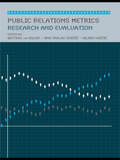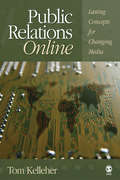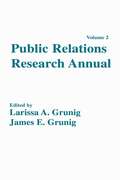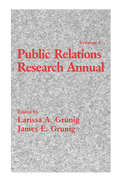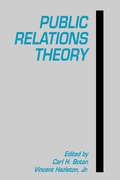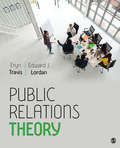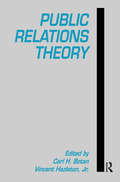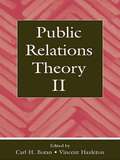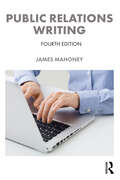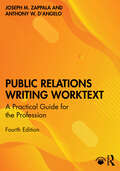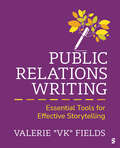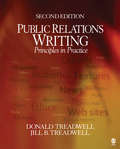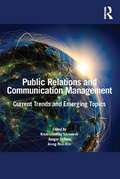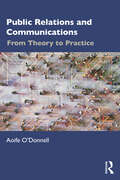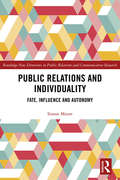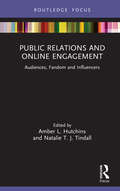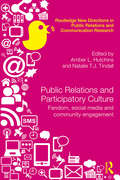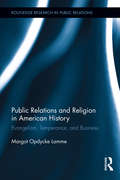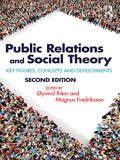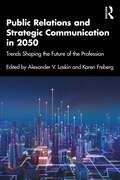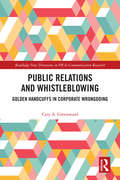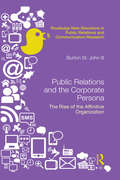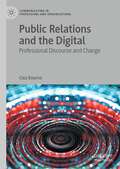- Table View
- List View
Public Relations Metrics: Research and Evaluation (Routledge Communication Series)
by Dejan Verčič Betteke Van Ruler Ana Tkalac VerčičResponding to the increasing need in academia and the public relations profession, this volume presents the current state of knowledge in public relations measurement and evaluation. The book brings together ideas and methods that can be used throughout the world, and scholars and practitioners from the United States, Europe, Asia, and Africa are represented.
Public Relations Online: Lasting Concepts for Changing Media
by Thomas A. KelleherRich in scholarly foundations combined with actual practice, Public Relations Online: Lasting Concepts for Changing Media connects the social and technological forces that are changing public relations. Using plain-talk discussion of theory and research, this book helps readers identify how lasting concepts for effective public relations can be applied in a changing media environment, and how a changing media environment affects the practice of effective public relations.Key Features:Provides "Hands-Online" activities: Internet resource exercises challenge readers to apply concepts to their world in "real-time" on the day that they read the chapter.Offers "Questionable Claims" boxes: Discussions present alternative perspectives on sometimes-over-hyped claims and serve to help sharpen critical-thinking skills.Discusses computer systems and networks: Server-side and peer-to-peer technologies are introduced as models for understanding online public relations.Focuses on how real people are using online media to communicate: Online public relations is more a matter of what people are doing with online media technologies than what these technologies are doing to people.Intended Audience:This text is designed for advanced undergraduate and graduate courses in Public Relations strategies and practices such as Public Relations Cases, Public Relations Management, Public Relations Strategy, and Public Relations Campaigns.
Public Relations Research Annual: Volume 2
by Larissa A. GrunigThe purpose of this second volume is to challenge and extend the field of research in public relations. Taking a proactive approach to creating a stable, yet not stagnant annual, the editors directly solicited chapters on exciting and intriguing subjects. Assuming some prior knowledge, interests, and commitment of their readers, the editors hope that each chapter's report on original research provides enough context for understanding even if the area of inquiry is new to the readers.Public Relations Research Annual, Volume 2, continues to advance within the discipline beyond anecdotes to practical theories and research. Educators, practitioners, and researchers will find this annual's presentations and critiques useful in creating a systematic framework for their own endeavors.
Public Relations Research Annual: Volume 3
by James E. Grunig Larissa A. GrunigPublished in book form, this is a scholarly periodical of academic research in public relations, containing refereed reviews and reports of original studies. It follows the current trend toward more solidly grounded, theoretical research in a field that has only begun to mature. The studies and reviews presented represent the most contemporary thought and investigation brought to bear on this subject. Many relevant topics are discussed, including communication roles, women's issues in the feminization of the field, the concepts of symmetry and game theory, and finally, publics -- dealing with roles, risk takers, and how audiences receive, process, and retain messages on public policy issues.
Public Relations Theory
by Carl H. BotanBeginning with the basic premise that public relations can best be understood as a specialized type of communication, the contributors to this volume establish public relations as a vital and viable realm for communication research and theory development. Through the application of communication theories, they attempt to explain and predict public relations practices and then use these practices to develop communication theories. Their discussions fall into three distinct categories: metatheory, theory, and examples of applications of theories. An ideal volume for professionals and students in communication, journalism, and related fields.
Public Relations Theory
by Eryn S. Travis Edward J. LordanReflecting the ever-increasing changes in the public relations industry, this new text offers a fresh, up-to-date look at public relations theories as well as theories from related areas that impact public relations. Chapters move from the oldest areas of communication theory through newer models devoted to interpersonal, organizational, and mediated, up to the most current theories devoted to emerging media, including digital and social. Readers will learn how public relations and persuasion theories are at the heart of a practitioner’s day-to-day work, and see how a strong understanding of theories can make them more effective and strategic professionals.
Public Relations Theory
by Eryn S. Travis Edward J. LordanReflecting the ever-increasing changes in the public relations industry, this new text offers a fresh, up-to-date look at public relations theories as well as theories from related areas that impact public relations. Chapters move from the oldest areas of communication theory through newer models devoted to interpersonal, organizational, and mediated, up to the most current theories devoted to emerging media, including digital and social. Readers will learn how public relations and persuasion theories are at the heart of a practitioner’s day-to-day work, and see how a strong understanding of theories can make them more effective and strategic professionals.
Public Relations Theory (Routledge Communication Ser.)
by Carl H. Botan Vincent HazletonBeginning with the basic premise that public relations can best be understood as a specialized type of communication, the contributors to this volume establish public relations as a vital and viable realm for communication research and theory development. Through the application of communication theories, they attempt to explain and predict public relations practices and then use these practices to develop communication theories. Their discussions fall into three distinct categories: metatheory, theory, and examples of applications of theories. An ideal volume for professionals and students in communication, journalism, and related fields.
Public Relations Theory II (Routledge Communication Series)
by Carl H. Botan Vincent HazletonThe public relations landscape has changed dramatically from what it was in 1989, when the original Public Relations Theory volume was published. Reflecting the substantial shifts in the intervening years, Public Relations Theory II, while related to the first volume, is more a new work than a revision. Editors Carl H. Botan and Vincent Hazleton have brought together key theorists and scholars in public relations to articulate the current state of public relations theory, chronicling the ongoing evolution of public relations as a field of study. The contributors to this volume represent the key figures in the discipline, and their chapters articulate the significant advances in public relations theory and research.Working from the position that public relations is a theoretically grounded and research based discipline with the potential to bring numerous areas of applied communication together, Botan and Hazleton have developed this volume to open up the public relations field to a broad variety of theories. Organized into two major sections--Foundations, and Tools for Tomorrow--the volume presents four types of chapters: discussions addressing how public relations should be understood and practiced; examinations of theories from other areas applied to public relations; explorations of theories about a specific area of public relations practice; and considerations of public relations theories and research that have not been given sufficient attention in the past or that hold particular promise for the future of public relations. It serves as a thorough overview of the current state of theory in public relations scholarship. Like its predecessor, Public Relations Theory II will be influential in the future development of public relations theory. Taken as a whole, the chapters in this book will help readers develop their own sense of direction for public relations theory. Public Relations Theory II is an essential addition to the library of every public relations scholar, and is appropriate for use in advanced public relations theory coursework as well as for study and reference.
Public Relations Writing
by James MahoneyPublic Relations Writing is an undergraduate communication and public relations textbook. It positions writing for public relations in the context of strategic planning, and is based on traditional communication writing principles, including for news and digital media. The book illustrates how writing for all public relations tools reflects the concepts that inform professional planning and practice.This book, based on the author's wide professional practice and tertiary teaching experiences, has been widely used in international undergraduate teaching and learning. This fourth edition continues to treat clear, concise and accurate writing for this profession as integral to all aspects of professional practice and as a skill that is not confined to media release writing. Among the book's strengths are the student exercises, including international cases, which are based on real-world examples, and references to ethical practice. This book provides a holistic approach to learning about writing in this profession. While its focus is on writing, this holistic approach, which includes material on planning a communication strategy, makes it an ideal text for introductory subjects at university as well as for specialist writing units. While it is primarily grounded in Australian practice, the book is written in line with accepted international approaches to public relations writing, including the principles of journalism’s 'news writing', and contains case studies from other countries. This book appeals to audiences in early-year university students studying public relations and marketing communication.It is also suitable for professional practitioners seeking to enhance their writing skills.
Public Relations Writing Worktext: A Practical Guide for the Profession
by Joseph M. Zappala Anthony W. D’AngeloWith a concise approach that engages students and practitioners, this thoroughly updated fourth edition provides the fundamental knowledge and basic skill preparation required for the professional practice of public relations writing.Building on the strengths of previous editions, this edition focuses more closely on PR writing as a strategic function and on planning and content strategy design. With practical advice from PR professionals, it covers everything from day-to-day business communications and media tools to writing for social media and crisis situations.This fourth edition incorporates a number of changes and updates, including: New chapters on Social Media and Writing for Key Publics and new content on the use of generative AI and its impact on PR writing. Expanded chapters on Writing for Digital Communications and on Publications, Presentations, and Speeches. New guest columns from PR professionals on topics including writing and pitching the media, inclusive writing, speech writing. and measuring writing/content impact. New cases and assignments based on topics, issues, and problems that public relations professionals face today. The text is suitable for undergraduate and graduate students in a public relations writing course preparing for entry-level public relations and communications roles, as well as a useful reference for early-career practitioners.Online resources also accompany the book: teaching materials, test banks, and reference sources. Please visit www.routledge.com/9780367860028.
Public Relations Writing: Essential Tools for Effective Storytelling
by Valerie FieldsPublic Relations Writing: Essential Skills for Effective Storytelling is a step-by-step "how-to" guide that helps students develop and hone the skills they need to become strong writers and versatile storytellers within the Public Relations field. Author Valerie Fields uses a practical approach, providing students with tips and checklists for producing high-quality content. Sample templates, writing exercises, and case studies in each chapter give students the opportunity to analyze and craft strategic messages for specific audiences. With a focus on storytelling, social media, and socially-conscious content, this text helps students understand the power of words within the larger context of our ever-changing media landscape.
Public Relations Writing: Essential Tools for Effective Storytelling
by Valerie FieldsPublic Relations Writing: Essential Skills for Effective Storytelling is a step-by-step "how-to" guide that helps students develop and hone the skills they need to become strong writers and versatile storytellers within the Public Relations field. Author Valerie Fields uses a practical approach, providing students with tips and checklists for producing high-quality content. Sample templates, writing exercises, and case studies in each chapter give students the opportunity to analyze and craft strategic messages for specific audiences. With a focus on storytelling, social media, and socially-conscious content, this text helps students understand the power of words within the larger context of our ever-changing media landscape.
Public Relations Writing: Principles in Practice
by Donald F. Treadwell Jill B. TreadwellPublic Relations Writing: Principles in Practice is a comprehensive core text that guides students from the most basic foundations of public relations writing-research, planning, ethics, organizational culture, law, and design-through the production of actual, effective public relations materials. The Second Edition focuses on identifying and writing public relations messages and examines how public relations messages differ from other messages.
Public Relations and Communication Management: Current Trends and Emerging Topics (Routledge Communication Ser.)
by Ansgar Zerfass Jeong-Nam Kim Krishnamurthy SrirameshPublic Relations and Communication Management serves as a festschrift honoring the work of public relations scholars James E. Gruning and Larissa A. Grunig. Between them, the Grunigs have published 12 books and more than 330 articles, book chapters, and various academic and professional publications, and have supervised 34 doctoral dissertations and 105 master’s theses. This volume recognizes the Grunig‘s contributions to public relations scholarship over the past four decades. To honor the Grunig’s scholarship, this volume continues to expand their body of work with essays from renowned colleagues, former students, and research associates. The chapters discuss current trends in the field as well as emerging issues that drive the field forward. Sample topics include theories and future aspects of the behavioral, strategic management approach to managing public relations, and its linkages and implications to related subfields and key field issues. Contributions stimulate academic discussion and demonstrate the relevance of applied theories for the practice of public relations and communication management with up-to-date concepts, theories, and thoughts.
Public Relations and Communications: From Theory to Practice
by Aoife O'DonnellThis book provides an introduction to public relations (PR) that employs pedagogical experiential learning models to assist students in developing the skills and competencies required by the PR industry.The book takes the reader on a journey from the theory and origins of PR, through to the structure of the PR profession and the more practical elements of how PR is practiced today. It devotes attention to the common competencies necessary for success as a communications professional, such as communication skills, critical thinking skills and business acumen, while giving due focus to the rapidly evolving new technologies and media that impact how organisations communicate. Featuring example cases from around the world, each chapter includes discussion topics and scenario-based questionnaires to encourage learning and assist students in developing key competencies.This book is ideal for undergraduate PR modules, particularly those with experiential and/or blended learning pedagogical approaches. It will also be useful to those in business seeking to gain a deeper understanding of communications.Situational Judgement Tests and sample press releases, presented as online resources, also accompany the book. Please visit www.routledge.com/9781032170435.
Public Relations and Individuality: Fate, Influence and Autonomy (Routledge New Directions In Public Relations And Communication Research Ser.)
by Simon MooreOur individuality is partly shaped by encounters with the external world so it is inconceivable that we are unaffected by the planned management of public communications which manages much of our external experience. Exploring one of the most important mediators between organizations and individual encounters – public relations (PR) – is long overdue. By developing new ways to create and connect with us as members of particular target audiences, has it changed our interior existence by altering perceptions of the world outside ourselves? PR’s massive impact on groups, society or organizations is rightly explored, but its immense influence on our individuality is neglected. In an age where new media makes deepening connections to individuals, the relationship of PR to individuality is one of the field’s most profoundly important issues. This provocative book will assist scholars and advanced students in PR and communication research to develop a clear, structured, disciplined understanding of this phenomenon and its implications.
Public Relations and Online Engagement: Audiences, Fandom and Influencers (Routledge Insights in Public Relations Research)
by Amber L. Hutchins; Natalie T. J. TindallAs media continues to evolve, social media has become even more integral to public relations activities, presenting new opportunities and challenges for practitioners. Relationships between publics and organizations continue to be first and foremost, but the process and possibilities for mutually beneficial relationships are being rewritten in situ. This volume aims to explore and understand highly engaged publics in a variety of social media contexts and across networks. The hope is the expansion and extension of public relations theories and models in this book helps move the discipline forward to keep up with the practice and the media environment. Contributors analyzed a range of organizations and industries, including corporate, entertainment, government, and political movements, to consider how public relations practitioners can facilitate ethical and effective communication between parties. A consistent thread was the need for organizations and practitioners to better understand the diverse backgrounds of publics, including age, ethnicity, gender, and sexual orientation, beyond surface-level demographic stereotypes and assumptions. This book will be of interest to researchers, academics, and students in the field of public relations and communication, especially those with a particular interest in online engagement and social media as a PR tool.
Public Relations and Participatory Culture: Fandom, Social Media and Community Engagement (Routledge New Directions in PR & Communication Research)
by Amber Hutchins Natalie T.J. TindallWhile public relations practitioners have long focused on the relationship between organizations and their stakeholders, there has never been a time when that relationship was so dominated by public participation. The new model of multiple messages originating from multiple publics at varying levels of engagement is widely acknowledged, but not widely explored in scholarly texts. The established model of one-way communication and message control no longer exists. Social media and an increasingly participatory culture means that fans are taking a more active role in the production and co-creation of messages, communication, and meaning. These fans have significant power in the relationship dynamic between the message, the communicator, and the larger audience, yet they have not been defined using current theory and discourse. Our existing conceptions fail to identify these active and engaged publics, let alone understand virtual communities who are highly motivated to communicate with organizations and brands. This innovative and original research collection attempts to address this deficit by exploring these interactive, engaged publics, and open up the complexities of establishing and maintaining relationships in fan-created communities.
Public Relations and Religion in American History: Evangelism, Temperance, and Business (Routledge Research in Public Relations #5)
by Margot Opdycke LammeWinner of The American Journalism Historians Association Book of the Year Award, 2015 This study of American public relations history traces evangelicalism to corporate public relations via reform and the church-based temperance movement. It encompasses a leading evangelical of the Second Great Awakening, Rev. Charles Grandison Finney, and some of his predecessors; early reformers at Oberlin College, where Finney spent the second half of his life; leaders of the Woman’s Christian Temperance Union and the Anti-Saloon League of America; and twentieth-century public relations pioneer Ivy Ledbetter Lee, whose work reflecting religious and business evangelism has not yet been examined. Observations about American public relations history icon P. T. Barnum, whose life and work touched on many of the themes presented here, also are included as thematic bookends. As such, this study cuts a narrow channel through a wide swath of literature and a broad sweep of historical time, from the mid-eighteenth century to the first decades of the twentieth century, to examine the deeper and deliberate strategies for effecting change, for persuading a community of adherents or opponents, or even a single soul to embrace that which an advocate intentionally presented in a particular way for a specific outcome—prescriptions, as it turned out, not only for religious conversion but also for public relations initiatives.
Public Relations and Social Theory: Key Figures, Concepts and Developments (Routledge Communication Series)
by Øyvind Ihlen Magnus FredrikssonPublic Relations and Social Theory: Key Figures, Concepts and Developments broadens the theoretical scope of public relations studies by applying the work of a group of prominent social theorists to make sense of the practice. The volume focuses on the work of key social theorists, including Max Weber, Karl Marx, John Dewey, Jürgen Habermas, Niklas Luhmann, Michel Foucault, Ulrich Beck, Pierre Bourdieu, Anthony Giddens, Robert Putnam, Erving Goffman, Peter L. Berger, Gayatri Chakravorty Spivak, Bruno Latour, Dorothy Smith, Zygmunt Bauman, Harrison White, John W. Meyer, Luc Boltanski and Chantal Mouffe. Each chapter is devoted to an individual theorist, providing an overview of that theorist’s key concepts and contributions, and exploring how these can be applied to public relations as a practice. Each chapter also includes a box giving a short and concise presentation of the theorist, along with recommendation of key works and secondary literature.
Public Relations and Strategic Communication in 2050: Trends Shaping the Future of the Profession
by Alexander V. Laskin Karen FrebergTaking stock of the technological, political, economic, and social trends that exist today, this book extends the discussion to analyze and predict how these trends will affect the public relations and strategic communication industry of the future.This book is divided into two sections, the first addressing such key topics as artificial intelligence (AI), big data, political polarization, and misinformation, the second looking at key facets of the profession, such as media relations, crisis communication, and measurement and evaluation. Leading researchers in the discipline share their analysis of these topics while also providing theoretically based and practically relevant insights on how the industry must evolve to keep up with, and perhaps anticipate, changes in culture, society, and technology.This book will be of interest to scholars, industry professionals, and advanced undergraduate and graduate students in public relations and strategic communication.
Public Relations and Whistleblowing: Golden Handcuffs in Corporate Wrongdoing (Routledge New Directions in PR & Communication Research)
by Cary A. GreenwoodThere is a growing interest in corporate whistleblowing, but no comprehensive research has yet focused on public relations practice. Drawing on extensive research on Fortune 1000 and Wilshire 5000 corporations, this book reveals executives’ attitudes and relationships toward their organizations and their impact on whistleblowing. Perhaps unsurprisingly, it reveals that wrongdoing in corporations and the privileges of power coexist. Top-ranking public relations executives, who are mostly white and male, are more likely to be aware of wrongdoing but no more likely to blow the whistle, fundamentally due to their positive relationship with their employers. Using the new lens of evolutionary theory, this study explains whistleblowing, retaliation, and relationships, and in the light of the connection between whistleblowing behavior and executives’ attitudes, it proposes a new theory of the phenomenon of Golden Handcuffs. As public attitudes to corporations, corporate social responsibility (CSR), and transparency harden, these findings have serious implications for companies globally. Researchers, scholars, and advanced students in public relations, organizational communication, corporate communication, strategic communication, corporate reputation, and CSR will find this book full of revealing insights.
Public Relations and the Corporate Persona: The Rise of the Affinitive Organization (Routledge New Directions in PR & Communication Research)
by Burton Saint John IIIFor much of the last century, large, predominantly US corporations used public relations to demonstrate that their missions resonated with dominant societal values. Through the construction and conveyance of the "corporate persona", they aimed to convince citizens that they share common aspirations - and moreover that their corporate "soul" works as a beneficent force in society. Through examining key examples from the last 80 years, this book argues that PR, through the corporate persona, works to create a sense of shared reality between the corporation and the average citizen. This has been instrumental in conveying, across generations, that the corporation is an affinitive corporate persona - a fellow companion in the journey of life. The construct is obviously ripe for manipulation, and the role of PR in creating and promoting the corporate persona in order to align corporations and stakeholders is potentially problematic. From wage inequality to climate change, preserving the corporate status quo may be negative. This original and thought-provoking book not only critically analyses how PR and its role in the corporate persona works to solidify power, but also how that power might be used to further goals shared by the corporation and the individual. Scholars and advanced students of public relations, organizational communications and communication studies will find this book a challenging and illuminating read.
Public Relations and the Digital: Professional Discourse and Change (Communicating in Professions and Organizations)
by Clea BourneThis book takes a people-centred approach to the ever-fluid and rapidly-transforming professional world of public relations (PR) in the age of digital platforms. As everyday PR work becomes increasingly shaped by the platform economy, this is transforming how the PR profession talks about itself, its issues and concerns. Drawing on different textual genres and discursive strategies, the author examines the shifting boundaries between PR and adjacent fields such as advertising, marketing and journalism – and illuminates varied lifeworlds of PR professionals from different backgrounds, races and genders. Written for academics, practitioners and those interested in the world of public relations, the book will also be enjoyed by young professionals working in this interesting and fast-changing occupation.
